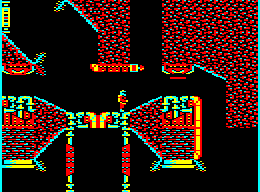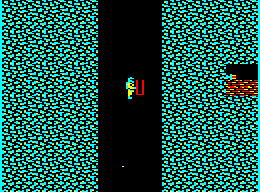Exile
You're Mike Finn, weary space hero. A research ship, the Pericles, sits stranded on the surface of planet Phoebus. Its crew is missing, their fate picked out in brief, terrifying radio bulletins from their captain. Triax, an arch-geneticist exiled from Earth for crimes against humanity, is responsible. You're underfunded and underequipped, and your mission? To rescue any survivors and to overpower Triax. Except now, Triax has stolen a crucial part of your ship, and you're stranded too. So it begins.

As happens with evolution, Exile's development took place at the very limits of what was possible, right from the very start. "Just compiling the game was right on the edge of being possible all the time because of the lack of RAM," Irvin recalls. "The source code was broken into lots of modules, each loaded from floppy and compiled in sequence. As time went on, these had to be broken down into smaller and smaller files just to fit in RAM with the object code."
Might it be posible to test today's more complex hardware with a new Exile? "Quite a few people ask about a sequel or updated version: after all, the hero, Mike Finn, has only had one adventure so far, and Triax lives on. I'd quite like this to happen, but only if it was better than the original, which means really concentrating on having the same immersive atmosphere and gameplay." That's not the only reason why Irvin has hung back from recreating Finn's universe. "I think it's only recently that computers have become powerful enough to do what I'd like to implement in a really detailed realistic 3D world for Exile. It's not just a matter of pretty bitmaps and numbers of polygons." Sadly, Smith passed away in 1992. Irvin still works in the games industry for his own company, Inventivity (www.inventivity.co.uk). He's remaining quiet about his current project, but reveals that it's a game designed to work on every platform from PDAs and Smart phones upwards, and that it has been allowed to evolve from basic principles, just like Exile. For now, then, those desperate for a sequel will have to be content with playing around with the versions of the game already available. "People keep asking about the extra text messages in the 68000 version, like 'She wants you badly', or 'You have killed Triax'. We put those in for hackers to wonder over," Irvin says. "Maybe."  The smiling secrecy is understandable. Why put any rumours to rest? In less than 150K of data, within 32K of RAM, Irvin and Smith created a world which still lives on today. It lives in the tribute Web sites, it lives through emulation, and it lives through the dedicated conversion projects. Most of all, though, it lives in the heads of those who played it. That's where Mike Finn is now, circling through the caverns of Phoebus, thrown around by the particle winds, spinning around in the sparkling black. That's Exile. That's freedom. The smiling secrecy is understandable. Why put any rumours to rest? In less than 150K of data, within 32K of RAM, Irvin and Smith created a world which still lives on today. It lives in the tribute Web sites, it lives through emulation, and it lives through the dedicated conversion projects. Most of all, though, it lives in the heads of those who played it. That's where Mike Finn is now, circling through the caverns of Phoebus, thrown around by the particle winds, spinning around in the sparkling black. That's Exile. That's freedom.
| ||||||||||||||||||||||||||


 1st January 2008
1st January 2008



 Enemies or more subtle object-based puzzles would block progress through the intricate cavern system and towards Triax's lair. Stealth and skilful flying could outwit the killers; equally effective would be a volley of fire from one of the five particle-based weapons strewn around the game world. Puzzles required a little more subtlety, but solving them remained a world away from the esoteric try-everything-with-everything-else methods seen elsewhere. Because the rules of Exile were grounded in real life, in gravity and mass and inertia, so were the answers to its questions. It's easiest to give an example: holding a heavy rock provided you with enough weight to counterbalance a strong updraft, and finding a jetpack booster gave you the added thrust needed to move downwards through it.
Enemies or more subtle object-based puzzles would block progress through the intricate cavern system and towards Triax's lair. Stealth and skilful flying could outwit the killers; equally effective would be a volley of fire from one of the five particle-based weapons strewn around the game world. Puzzles required a little more subtlety, but solving them remained a world away from the esoteric try-everything-with-everything-else methods seen elsewhere. Because the rules of Exile were grounded in real life, in gravity and mass and inertia, so were the answers to its questions. It's easiest to give an example: holding a heavy rock provided you with enough weight to counterbalance a strong updraft, and finding a jetpack booster gave you the added thrust needed to move downwards through it.

